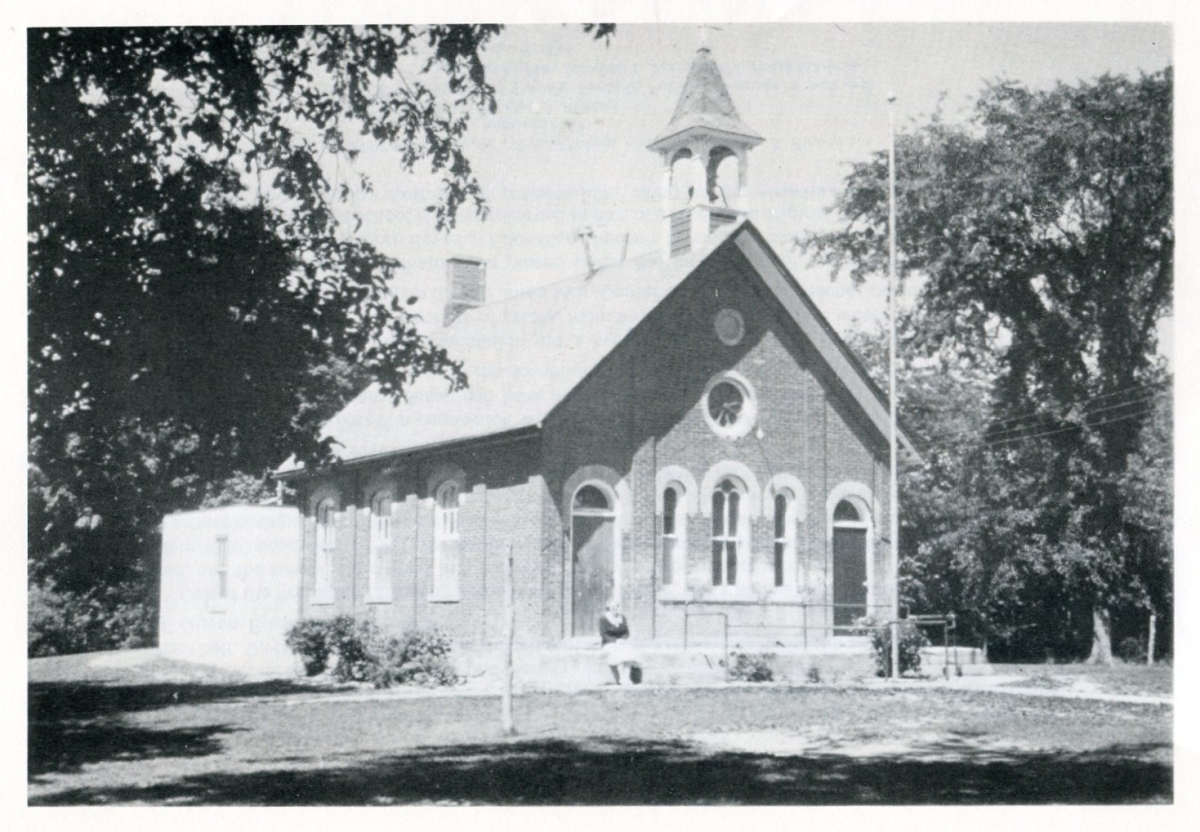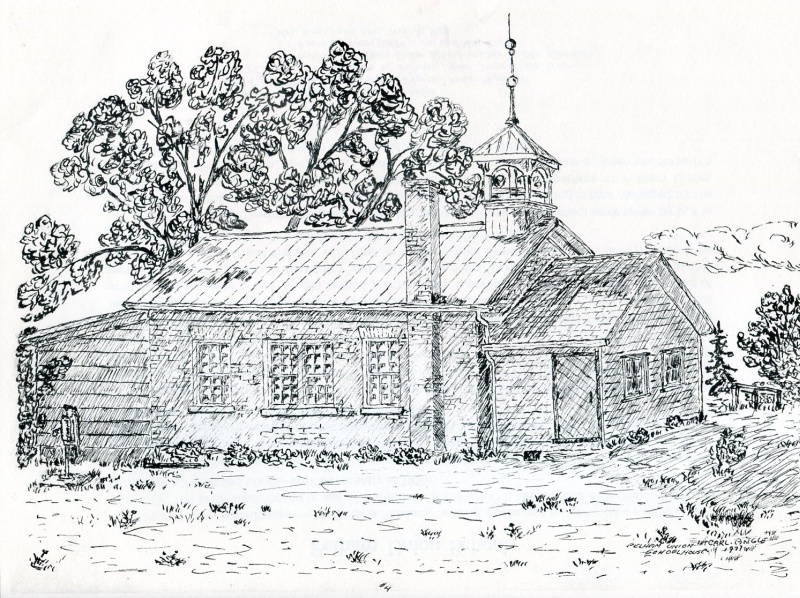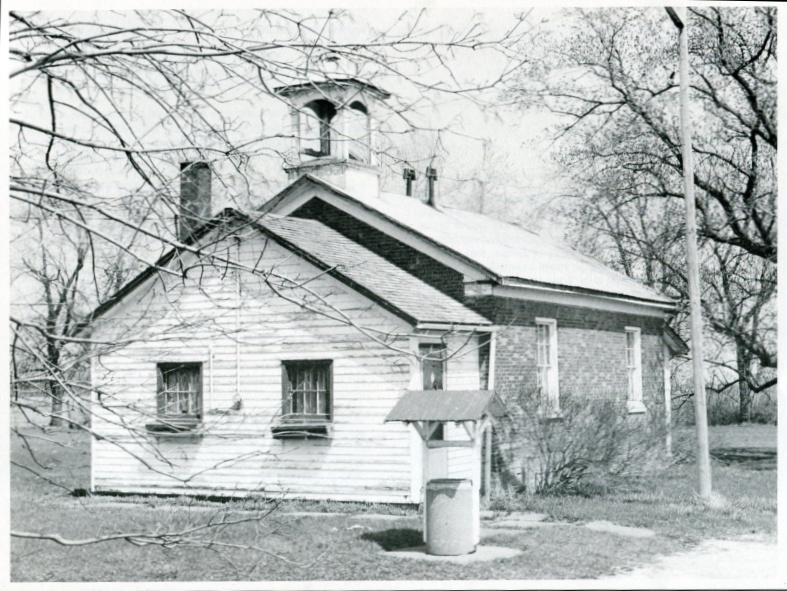[Pelham Historical Calendar 1978]
IN 1922,the trustees of S.S.#9 Mr. G. Kappler, Mr N. Swayze and Mr. N Stirtzinger felt a local school was needed for students who were then travelling by train to Smithville or to Welland to continue their education. First classes were held in the public school on Baxter Alley (now an apartment building). Enrolment increased and plans were made for a permanent school.
On December 16, 1927 a formal opening was held for the new “Pelham Continuation School”. Within ten years a complete schedule of Upper School subjects was taught and agricultural courses were introduced. The original student body of 7 had grown to 125. In 1943 s second storey was added and two years later a two-storey rear addition, The Continuation School became “Pelham District High School” in 1949 and students were brought in daily on buses from the Townships of Pelham, West Lincoln, Gainsboro, part of Thorold and Fonthill Village. More classrooms and facilities were added in 1950-51 and in 1956 to accommodate the 850 students. The opening of two new schools in the areaThorold-Fonthill (1958-1970) and E.L. Crossley (1963) eased the strain on Pelham’s High’s facilities.
In 1970 the school became “Pelham Secondary School”. But it was not long to remain an active school. Discontinuation of an agreement that brought in West Lincoln students resulted in a decrease in students and was a factor in the Niagara South Board of Education’s decision to close the school. There was strong community pressure to keep the school open, but the Board’s decision prevailed and the school closed in June , 1974. Pelham Secondary School had served the Fenwick area well, and to the end the community fought for the heritage , high standards and close staff-studentt relations.
Many staff are well remembered: Principals Mr. F.M. Hicks, Mr. W.G. Spencer, Dr. E.L. Crossley, Mr. T.D. Wallace and Mr. E.A. Ker; early teachers Miss M. Metler, Miss J.M. Bell, Miss De La Mater; and many people including Mr. Irvine Muir and Mr. James Robertson, who headed the “Save Pelham” campaign.
In the summer of 1975 desks, machinery and equipment were put up for auction. It has remained closed ever since and is now in private ownership.
Mr. Kerr wrote in the 1974 “Pelham Pnyx”, the last edition of the school magazine; “But we may be sure that, in any event, as long as there are descendants of its students, the influence of Pelham continue for generations”.
[Pelham Historical Calendar, 1978]
This handsome brick school was built in 1883-83. It was a one-room schoolhouse designed with a stately symmetry, two front entrances at each side, a frieze of arched windows between vertical columns of raised bricks, central rose window and steeply pitched roof crowned by a graceful tall cupola with the school bell. On the flagpole is a crown-shaped metal plaque commemorating the coronation of George V1 and Queen Elizabeth, May 1937.

One of the first school trustees in the area, a Mr. Reece, donated the land for the school on Sixteen Road, and the school was named in his honour. Many improvements were made through the years a well in 1920, woodshed in 1927, the flagpole, and in 1941 the school was serviced with electricity. In 1945 the school became part of Pelham Area #1. A few years later bus service was begun. The playground was enlarged through purchase of a half-acre from Mr. Albert Wegman, and a fence was built to protect the playground from the waters of the Fifteen Mile Creek which ran nearby through the quiet, wooded country setting of the school.
Many are remembered in connection with the school, teachers such as Miss Bessie Nelson, Mr. Charles Elliott, Mrs. George Alsop and Miss Jean Davidson, and also Mrs. C.B. Leppert (nee Reece) who lived in the family hoe next to the school and for fifty years kept the school clean and polished.
The Ontario Horticultural Association did a great deal to encourage the beautification of rural schools. Reece’s School won its share of prizes, including a first prize in 1945 when Mrs. Violet Bissell was teacher-principal, and again in 1963 when Mrs. Catherine B. Rice was teacher-principal.
When the schools of Pelham were placed under the jurisdiction of the Welland County School Board, now the Niagara South Board of Education, Reeces School was closed, along with the North Pelham and Law’s Schools. The school is now preserved as part of a home, the original facade integrated into an outstanding and beautiful example of preservation, using an old structure and modern additions.
REECE’S SCHOOL
[Author unknown]
The land for this school was donated by Mr. Reece , one of the first trustees.
The school was given its name in his honour. Construction was begun in 1882 and was ready in 1883.
The one-roomed brick building housed grades one to eight. (First Book to Fourth Book) The desks were single and no platform was at the front of the room. Some of the items of interest of the early days were:
1920—a well was dug
1926—teacher’s room, supply room added
1927– a woodshed added
May 6, 1937– a steel flagpole
1941—electricity installed
Oct. 3, 1941– a piano purchased (repairing and tuning of same, paid by students)
In 1944, first prize was awarded this school for the Rural Schools’ Beautification Contest, In 1945, the school became part of Pelham Area #1, and in 1949, bus service for the schools of the area came into being.
One-half acre to the west of the school was purchased from Albert Wegman in 1955, for the purpose of enlarging the playground. The area was surrounded by a new fence.
In 1955, an addition consisting of a furnace room, washrooms. Teachers’ room, and store room was built at the north end of the original building. In 1956, the woodshed was purchased by Mr. G. Goodfield. Dec. 3, 1956 filing cabinets were installed..
This school was situated on 16 Road and with the introduction of the Niagara South Board of Education, the school was sold.. It is now (1971) the home if Dr. C.W. Gillen.
TEACHERS—REECE’S SCHOOL
Miss McLure
Miss McLeade
Miss G. Milles
Miss Haines
Mr. Cline
Miss Wyatt
Miss Eskhardt
Miss Presswell
Miss Davis
Miss Hendershoy
Mr/ J.P. Pegg
Mrs. Tergrison
Miss McCullum
Miss Nelson
Mr. Elliot
Miss McIntosh
Miss V. Berry (1928-33)
Miss E. Pirie
Mr. L. Wipple
Miss Robins
Miss F. Scrutun
Miss Wessel
Miss S. Oille
Miss M. Davidson
Miss Gleason
Miss Gilmore
Mrs. V. Bissell (1940-50)
Miss J. Stewart (1951-53)
Miss D. Raddon (1953-54)
Miss J. Davidson (1954-55)
Miss M. Seburn (1955-56)
Miss I. Dueck (1956-57)
[Author Unknown]
This one-room schoolhouse was built in 1852, and served pupils from four townships- Pelham, Gainsborough, Clinton and Louth- until 1965, when it closed. The land had been bought for five pounds from John Cosby and the present school built, replacing an earlier from structure located on the opposite corner. The bricks were made from clay found on the Cosby farm.
A bell was purchased in the early 1900’s, a large slate blackboard installed and an organ and piano were bought for musical instruction. In 1907, additional land was purchased and the school grounds were extended.In 1945, Pelham Union School won first prize in the school beautification contest in Welland County and fifth provincially. The school continued to win prizes, with pupils planting shrubs, a perennial garden, a large circular bed of annuals, and window boxes on the west wa;; filled with bright flowers. Fence posts, a flagpole and pump were kept painted, and a bucket well was erected with funds from the prize money.
The Pelham Recreational Board assumed control of the school when it closed in 1965 and the Women’s Institute of Pelham Union began to use it as a meeting place and community hall.


PELHAM UNION SCHOOL
[Pelham Historical Calendar 1978]
The one-room schoolhouse- with Ontario Readers, heating stoves and inkwells- is a memory now.This little,red brick schoolhouse is one of the oldest in the area. It served four townships- Pelham, Gainsboro, Clinton, and Louth- until as recently as 1965.
The 100th anniversary of the school was celebrated in 1952. A century earlier, “Twenty-one Square rods of land were bought for five pounds from Mr. John Cosby”, and the present brick school was built, replacing an earlier frame structure on the opposite corner. A brick-making machine was used to shape clay from Mr. Cosby’s farm into the bricks for the school.
In the early 1900’s a bell was purchased, a large slate blackboard installed and an organ and piano were bought for the musical instruction offered to the children. The sturdy double desks were still in use when the school closed, and many desks were bought by former pupils. In 1907 more land was purchased and the school grounds were extended.
School Beautification Contests were an important part of school life. In 1945 Pelham Union School won first prize in the Welland County contest and fifth provincially. Each year after that the school entered and received prizes. Pupils helped plant shrubs, a perennial garden, a large circular bed of annuals. Window boxes brightened the west wall. Fence posts, flagpole and pump were kept freshly painted. A bucket well was erected, with funds from the School Beautification prize money, when Miss Lillian Neal retired in 1951 after teaching in the school for thirty-nine years.
When thr Pelham Township school area was formed the children of this school were taken by bus to other Pelham schools. Pelham Union School closed in June 1965. The building is now managed by the Pelham Recreation Board. It is used and looked after by the Women’s Institute of Pelham Union, Community Buildres Branch. The school, in outer appearance, is much the same as when the three R’s were drilled, and the mornings began with singing “God Save The Queen.”
U.S.S. no. 7 PELHAM UNION (PUTT’S INN)
[Author Unknown]
This school is one of the oldest in the area and is situated in the northwest corner of Pelham Township. The pupils of U.S.S. #7 lived in Pelham, Gainsborough, Clinton and Louth Townships. As the records have been inadvertently destroyed, information has been meagre and this has been compiled from the memories of pupils.
Little is known of the first school which was a few yards south of the present building, on rather low ground.
Around 1850, the present brick building was constructed on the corner of “Schoolhouse Lane” and the “Townline.” This small lot was a part of the property owned by Murray Cosby. It had been granted to the Cosby family as United Empire Loyalists. Later, the farm was owned by his daughters, Mrs John Haist who taught at the school in the late 1880’s with about 8 dozen pupils. The school yard was small with a board fence just west of the well and a few feet north of the school. The woodshed was a small separate building.
In the early days, the desks were long and placed lengthwise in the room under the windows. These long desks and benches were often a disturbing factor when one pupil wished to raise the desk lid while the other wrote. From about 1875 until the school was closed, double desks without lids were used in the traditional arrangement in the room. Samples of these desks may still be seen in the neighbourhood.
The older boys took turns building the wood fire to heat the building. Periodically, a fire was lit outdoors to heat water for the girls to scrub the floor. The small entry at the west was a place for the water pail and dipper and for coats.
Probably in the early 1900’s, the school yard was doubled in width and extended west to the town line. The rather large woodshed was attached to the east end of the building.
During Miss Neal’s forty years as teacher, many things changed. Even though there was caretaker services for lighting fires and sweeping the floor and dusting, one day in May was a cleaning day. On Arbor Day, pupils brought cleaning equipment, rakes and hoes, etc. The yard was raked windows, woodwork and floors were cleaned and flowers planted. Work proceeded quite rapidly even though the number of pupils were often very small because the day ended with a walk to the woods for wildflowers. This was generally to the corner of the Town Line and Tintern Road on the farm of Mr. Peter Bradt.
Christmas concerts were big events when stage entrances were made from icy woodshed or from behind the piano. Lighting was by coal oil lamps and later, from borrowed Mantle Lamps or gasoline lanterns. In the early 1930’s, the school was wired for electricity.
The original entry was doubled in size in the 1940’s and converted into washrooms. The old box stove was replaced by an oil space heater about 1955.
In 1965, the Township School Board decided to close the school and transport all pupils south to larger schools. The Community Builders Branch of the Womens’ Institute considered buying the property.. On Hallowe’en however, in that same year, fire destroyed the woodshed and much of the interior of the main building. The Community Builders have done much renovation and are using the building for their activities.
Teachers at U.S.S. #7 (Putt’s Inn)
Flavell Davis 1867-?
Isaac Moyer
Miss Effie Miller 1885-1888 ?
Miss Maggie Cosby (Mrs. John Haist)
John Comfort
Adison Moore
Geo. Henry (6 Mos.)
Adison Moore
Flavell Davis 1896- ?
Miss Lily Lampman
Miss Anna Sheldrick
Miss Mabel Huff (Mrs C. Van Every, Beamsville 1905-1907
Miss Sara McDougall (Mrs. Lorne Gordon, Harrison 1907-1909
Miss Irene Wright
Miss Smart
Miss Lillie Neal 1912-1952
Mrs. Gerald Martin 1952-1955
Mrs. Fretz 1955-1956
Miss Spencer 1956-1957
Mr. James Perry 1957-1962
Miss Wiebe
Mr. Kenneth Hill 1963-1965
Inspectors
Mr. Ball 1880’s
Mr. W.W. Ireland 1905-1913 ?
Mr. Carefoot
Mr. Marshall
Mr. Runnalls
Mr. Peat
For many years, music was taught by St Catharines teachers on a regular basis. The teachers were—Mr. Arthur Hannahson, Mrs. Eva Griffin, Mr. Geo Hannahson.
 Subscribe..
Subscribe..


